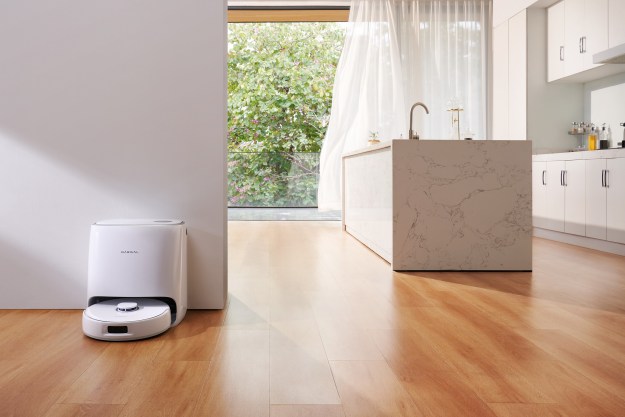HEPA filters have become an increasingly common option in smart homes for those who really, really want to make sure they’re removing every bit of allergen or potential infectious particle. Often found in air purifiers, a HEPA (high-efficiency particulate air) filter is designed to remove at least 99.97% of particles 0.3 micron in size or larger.
Such a highly efficient filter can quickly fill with clogging particles as you vacuum, which means users should be ready to regularly clean them, too. But HEPA filtration can get complicated based on the type of filter your device uses. Let’s go through the important FAQs you should know about HEPA filters in vacuums.
Are all vacuum filters HEPA?

No, and this can get tricky. A true HEPA filter is what we mentioned above — a filter rated to capture at least 99.97% of particles 0.3 micron or greater. That’s a lot of air particles, including anything that might be dangerous like viruses, pet dander, and even the tiniest pollen particles. The catch is that few filters are actually true HEPA, and they are even rarer on home vacuums.
This doesn’t stop marketing blurbs from claiming that vacuum filters are HEPA, often using the word “HEPA” or “HEPA-like” as a catchall to insinuate, “It’s a really good filter, guys.” True HEPA filters are large and generally shaped like thick columns: That makes them rare on vacuum cleaners and more common on air purifiers that have lots of room for filters. You can find HEPA-level filtration on some larger canister and upright vacuums, usually combined with advanced sealing to trap all possible dust particles, but don’t confuse this with a certified HEPA filter.
Can you clean a true HEPA filter?
Not really. In nearly every case, HEPA filters are designed to be replaced entirely. If a HEPA filter is marked permanent, it’s almost certainly not a true HEPA filter.
HEPA filters are so efficient at filtering out particles, most of the particles they capture end up embedded deep inside the filter’s substrate. That means you can’t clean out a HEPA filter by vacuuming it, which would only take off some of the surface particles and increase the chance of permanently damaging the filter.
HEPA filters are also not designed to be washed. Washing a true HEPA filter can easily damage it so that it can no longer filter properly. Plus, the amount of particles washing it will remove will be low anyway.
How do you clean a HEPA-like filter?

All right, what about vacuum filters that aren’t true HEPA but are designed to be permanent? How do you wash them? As always, it’s a good idea to read the manual and see what sort of cleaning it suggests. If it’s all right to wash the filter, then run it under cool (not warm) water with a tiny amount of detergent until the water runs clean. After that, it’s important to leave the filter out to air dry for around 24 hours, until it is entirely dry. Otherwise, a little moisture could cause mildew problems when the filter is put back into the vacuum cleaner.
If your HEPA-like filter or true HEPA has a pre-filter to trap larger particles, you should always take these out and wash them every few months. Pre-filters are sturdy, and almost always designed to be permanent, so frequent washing won’t hurt them.
When do you need to replace HEPA vacuum filters?
When to replace a HEPA vacuum filter can vary based on use. Generally, HEPA filters in residential use can last two to three years before they need to be replaced. In commercial scenarios, HEPA filters are replaced every several months or so. Generic “HEPA” filters may need to be cleaned every several months too, especially smaller filters used on stick vacs and similar models. Manuals can provide more specific information. There are also signs that a filter has outlived its purpose — mildewy smells or the sudden return of allergies can indicate it’s time to look up your device model and order a compatible replacement filter.
What about robot vacuums? Do they have HEPA filters?

No. Although again some may use the word HEPA, robot vacuums are too small for true HEPA filtration. However, models can use high-efficiency filters that still do a solid job of capturing particles. iRobot, for example, claims that its high-efficiency Roomba filters can capture 99% of dog and cat dander.
Are Roomba filters washable?
No, Roomba filters are generally not designed to come into contact with liquid, which can damage them. However, basic filters are designed to be cleared up from time to time by tapping the filter against your trash to displace debris. The high-efficiency filters we mentioned above often need to be replaced entirely.
Editors' Recommendations
- How to save Ring Doorbell video without a subscription
- Dyson’s new AR mobile app shows where you forgot to clean
- Best vacuum deals: Cordless to corded, Dyson to Bissell
- Ecovacs Deebot X2 Combo vs. Ecovacs Deebot X2 Omni: what’s new on the X2 Combo?
- Roborock S8 MaxV Ultra vs. Roborock S8 Max Ultra: Which is the better robot vacuum?




